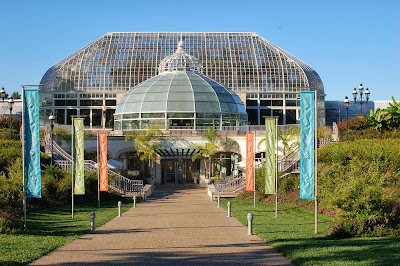by Judy Thomas
The Phipps Conservatory in Pittsburgh, PA
I attended my first American Society of Botanical Artists conference September 24-28 in Pittsburgh, PA (that includes a two-day, pre-conference workshop taught by Libbie Kyer called "Colored Pencil: Wet and Wild.") I am full of impressions, skills, ideas and experiences I want to share, and am also totally swamped after missing a week of work and home life! So, I will do my best and will hit what I think were the highlights of the conference.
I took the pre-conference workshop with six other colored pencil (CP) artists or those exploring the medium. Libby had a structured approach to teaching specific materials, tools and techniques. We first learned how to achieve deep hues (and avoid paper speckle) using a partial, black CP underpainting (yes, many CP artists call their work a "painting," not a "drawing" and yes, black!) and lightly touching it with an alcohol solvent. The subject for this was an eggplant, though we also did studies of a pepper. Next, we worked on contours and shading, then we moved onto gestural drawing (a quick capture of the object using a graphite pencil held flat, in the tips of one's fingers). Libby stated this this does a great job in capturing the size and dimensions of the subject of study without measurement. After a few tries, I found it worked, and it created an image with greater movement and life than my usual, more tediously and minutely-drawn subjects. This is a technique I will use in the future. After working to find up contours and shapes, we transferred the image to our final paper and began CP work.

End of workshop review, Libby in center.
Another highpoint of the conference was the portfolio review. Any member can sign up to do this (though the total number is limited) and it demonstrated the breadth and depth of work ASBA members produce. I came away elated, determined to improve my work and slightly intimidated by the skill on display!
Portfolio review in the Pittsburgh Athletic Center
Wow!
I also attended an educator's workshop. The presentations were geared toward teaching watercolor, but I learned a few things about skill practice and critique. I attended Wendy Hollender's "Racing Nature" class where she taught her method of quickly achieving depth of color. Wendy often uses sepia, and other dark tones (indigo, a dark green and burgundy) for shading, and applies water color pencil and other color pencils over the top. I used a deep purple-brown (Faber Castell Caput Mortem) for shading on my bright pink zinnia and it worked!
The last class I attended was "Complex Subjects." The only objection I had to this class (and Wendy's class) was that three hours is too short a time to learn and practice what you have learned. The teacher, Lee McCaffree was excellent. She showed us different ways to simplify complex forms of line, texture and form. In the class, we tried to capture the pattern of what we were drawing, to simplify it to its geometric elements, and add in details.
Complex subjects class
Below is my attempt at a sequoia cone. See the bit of kneaded eraser on the cone? This is to mark a reference point, so I can keep track of where I am. With a larger object, you can move the marker (a bit of tape, tack or kneaded eraser) as you go so you can track what you have already done. This cone follows a pattern of a double spiral. We also tried to draw flowers using a circular spiral or bulls-eye pattern (depending on the flower), but time was too limited to get far.
I don't have pictures of the Hunt Institute botanical art opening (a huge crush-I wish I had gone on my own). I took many photos in the Phipps Conservatory, too many to post. I did take many photos walking around Pittsburgh, and met some interesting people (Phyllida Barlow, an installation artist who was assembling a massive installation in front of the Carnegie Art Museum
http://en.wikipedia.org/wiki/Phyllida_Barlow She is a descendant of Charles Darwin! I also spoke to a CMU art professor, and went to a bizarre art show at the CMU student gallery). I will leave you with a charming image of Pittsburgh, a community-grassroots art project, "Locks of Love" (for more info, see
http://weburbanist.com/2011/01/12/locks-of-love-urban-padlock-monuments-to-commitment/ )
Next year Denver?








































.jpeg)










